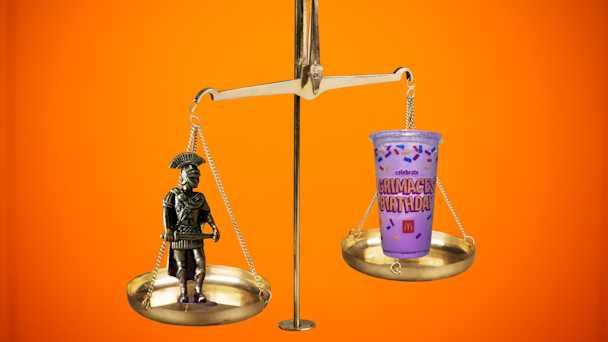Trendflation makes it impossible to discern between priceless and worthless trends
Men think about the Roman Empire just about as often as marketers consider hijacking online trends. GoodQues’s Maria Vorovich explores when to get involved.

Is the #WesAndersonChallenge right to drive attention for your social media? Should a food brand keep cashing in on the girl dinner conversation? How long can we invest in the cultural currency that is the Roman Empire?
This pace of trends is exhausting and demands lightning-fast decision-making. Fifteen years ago, trends bifurcated into two categories: mass culture and cool kid culture. Mass culture blasted from the radio, replayed on MTV and smiled at you from every magazine cover. The cool kids craved something more niche; they read zines instead of national publications and went to underground jam sessions versus stadium concerts.
For culture, this was a simpler time; for brands, it was a magical time. Brands decided, “Will we attract more customers by tying ourselves to mass culture or niche culture?” Mass trends were easy to identify and latch on to; the right cool kid could foster connection between a brand and a sexy niche trend.
Explore frequently asked questions
Today, brands have much more choice – too much choice. We are living in an overabundance of culture, a content gridlock and trendflation. A 2023 McKinsey newsletter defined trendflation as “the exponential rise in mass manufactured ‘trends’ met with decreased cultural value and/or impact.” Cottagecore, beige flag, loud budgeting, quiet luxury, almond mom – cultural movements exploded into a million micro-directions, and there’s no predicting how popular each trend will become and whether there will be a backlash that takes the trend from cool to cheugy in a TikTok second.
If you think financial inflation remains stubbornly high, trendflation is soaring to even more dizzying heights with no indication of a plummet. Approximately three decades since the internet was unleashed on the public, we’re living through a severe content crisis and quickly learning that more isn’t better. The internet feels more congested than the 405 during LA rush hour.
To complicate things, influencers and influencer wannabes are capitalizing on our cultural disorientation and trend mayhem. Vox recently reported on seeing online creators manufacturing jargon with the singular goal of making it a “thing” in culture. “Unlike slang, which generally spreads organically… these phrases are invented for a more cynical purpose: that other people might use them.”
Advertisement
When there is a road in every direction that you look, what’s a culturally conscious brand to do? How should you choose which trends to partake in? How do you know which trend will have staying power?
Because of trendflation and the endless questions it will continue to pose, businesses must adjust their compass for more accurate decision-making, to discern which cultural moments are worthy of brand action – whether communications, new products or services, R&D development or beyond.
A reliable framework for determining if a trend is worthy or worthless to your brand and business. To begin, every time you consider a trend, write out:
Our audience cares about X. The reason that they care about X is Y. By participating in this trend; our brand can make our audience’s lives better by Z.
For example, let’s say your audience cares about loud budgeting. And the reason that they care about loud budgeting is that they’re worried about the economy and their personal financial situation. By participating in this trend, our brand can improve our audience’s lives by offering real financial advice.
Advertisement
This statement unlocks a myriad of creative possibilities. A consumer banking brand may partner with an influencer to dole out saving best practices or might invest in a Chatbot to empower youths to ask for smart banking advice (ie, When should you open your first credit card? How do you build credit?) Those are just two in a vast range of creative opportunity.
Or maybe your audience cares about beige flags. They care about beige flags because dating in 2024 has become a real struggle, full of emotional disappointments and dating failures. By participating in this trend, our brand can improve our audience’s lives by giving them hope with stories of love successes despite some beige flags.
Again, infinite creative possibilities for brands in various categories arise. An automotive brand with values around storytelling might decide to participate in this trend by sharing stories from their employees and how love overcame a beige flag or two. This humanizes the brand, connects the brand to a cultural moment and offers real value to the conversation.
Suggested newsletters for you
Consider this approach whenever your brand contemplates engaging in a cultural dialogue as subsequent decision-making becomes more straightforward. While this framework doesn’t predict trend size, popularity, or longevity, it can provide tangible value–be it emotional or functional–for your target audience. It’s the most reliable method to discern whether a trend is worthy or worthless for your brand, business, and your consumers.
Cultural trends usually reflect deeper human truths, with underlying motivations, desires and values driving these trends. Amid an internet drowning in abundance, refrain from adding to the noise. Provide people with substance and reap the dividends – literally and figuratively.

